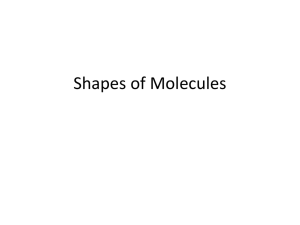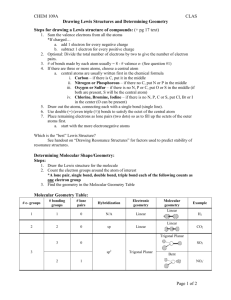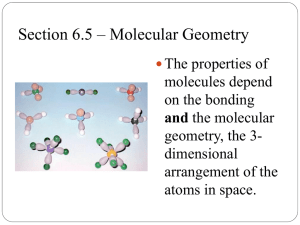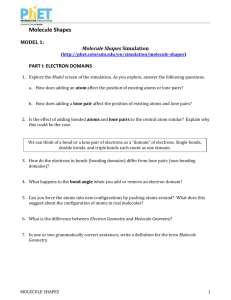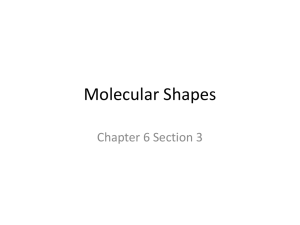Molecule Shapes: VSEPR Theory Worksheet
advertisement
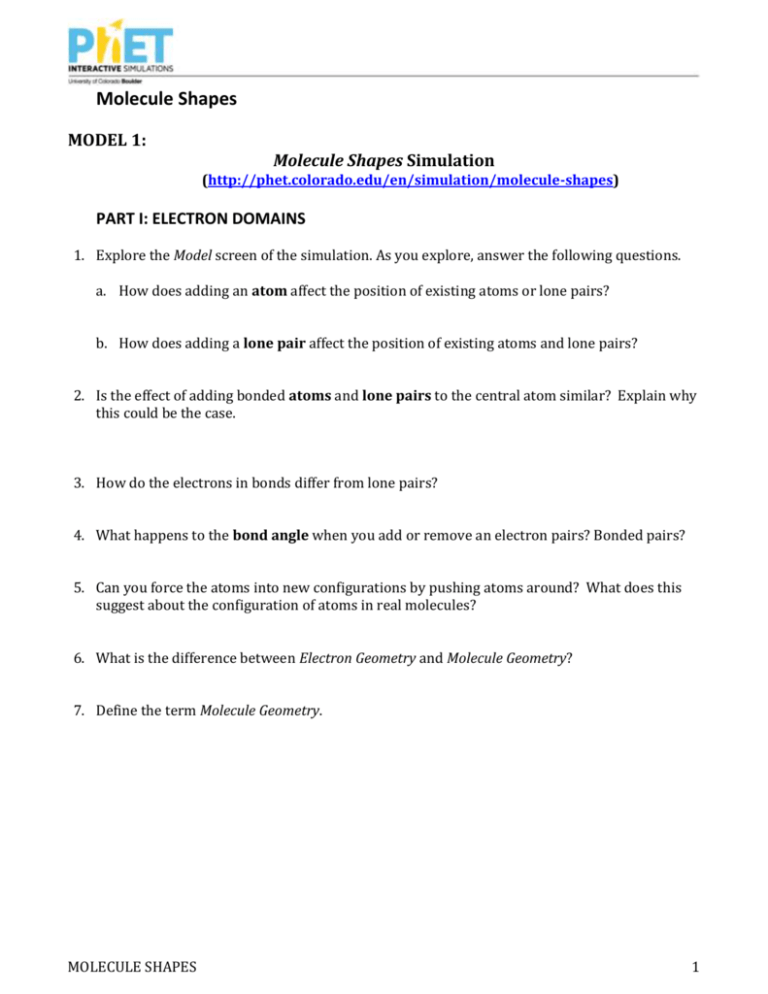
Molecule Shapes MODEL 1: Molecule Shapes Simulation (http://phet.colorado.edu/en/simulation/molecule-shapes) PART I: ELECTRON DOMAINS 1. Explore the Model screen of the simulation. As you explore, answer the following questions. a. How does adding an atom affect the position of existing atoms or lone pairs? b. How does adding a lone pair affect the position of existing atoms and lone pairs? 2. Is the effect of adding bonded atoms and lone pairs to the central atom similar? Explain why this could be the case. 3. How do the electrons in bonds differ from lone pairs? 4. What happens to the bond angle when you add or remove an electron pairs? Bonded pairs? 5. Can you force the atoms into new configurations by pushing atoms around? What does this suggest about the configuration of atoms in real molecules? 6. What is the difference between Electron Geometry and Molecule Geometry? 7. Define the term Molecule Geometry. MOLECULE SHAPES 1 PART 2: DRAWING MOLECULES TO SHOW 3-DIMENSIONALITY MODEL 2: Line, Wedge and Dash Drawings Line: In the plane of the paper: _____ Wedge: Coming forward, in front of the plane of the paper: H3C H C Dash: Going backward, behind the plane of the paper: 3 CH3 CH3 8. Where is each of the 5 atoms in the molecule CHFClBr? In the plane of the paper ______ ______ ______ In front of the plane of the paper ______ Behind the plane of the paper ______ 9. Using the Model screen, add bonding domains (●) to the central atom (○). Using lines, wedges and dashes from Model 2, draw each molecule’s shape. Bonding Atoms Around Central Atom Drawing of Shape Electron Geometry Bond Angles 2 ●─○─● Linear 180º 3 ○ 4 ○ 5 ○ 6 ○ MOLECULAR SHAPES 2 10. In the Model screen, build a molecule with 5 atoms attached to the central atom. Look at the molecule geometry and electron geometry. Predict what will happen to the molecule geometry as you replace atoms with lone pairs. Your Prediction: 11. In the following table draw the molecule geometry. As a group, make a prediction for each first, and then compare your answers with the simulation. Predict First, Then Compare with the Simulation Number of Domains Around Central Atom 1 Lone Pair 2 Lone Pairs 3 Lone Pairs 4 Lone Pairs 3 4 5 6 MOLECULAR SHAPES 3 PART 3: COMPARING MODEL VS. REAL MOLECULES 12. Explore the Real Molecules screen. c. List the molecules that show a difference in bond angle between “Real” and “Model”. Note: differences in bond angle may be small. Molecule Number of Lone Pair Domains d. What do all of the molecules in the table have in common? e. What trend do you observe that distinguishes lone pairs from bonding domains? 13. Use the simulation to build a system with 5 bonds. This is called a trigonal bipyramidal structure. The two different sites in a trigonal bipyramid are labeled as A and B in the drawing to the right. f. Each A atom is adjacent to 3 B atoms. What is the A-C-B bond angle? g. Each B atom is adjacent to 2 A atoms and 2 B atoms. What is the B-C-B bond angle. h. In a system with 4 atoms and 1 lone pair, predict whether the lone pair will be in a B site or an A site? Explain. i. Examine the molecule SF4 in the Real Molecules screen to check your prediction from question c. Which interactions are more important in determining where the lone pair will go? MOLECULAR SHAPES 4 EXERCISES: 1. A molecule has 2 double bonds on the central atom and no lone pairs. Predict the electron geometry. Predict the molecule geometry. What do you think the bond angles would be? 2. For each of the molecules below, determine the electron geometry, molecule geometry, and bond angles. Draw pictures to show your geometries. a. CCl4 (4 Cl atoms, no lone pairs on C) b. PF3 (3 F atoms, 1 lone pair on P) c. OF2 (2 F atoms, 2 lone pairs on O) d. I3- (2 I atoms and 3 lone pairs on central I) 3. Use any resources required to add names to all the geometries in the table on page 3. Challenge Question: Imagine a molecule with 7 atoms. The geometry is called pentagonal bipyramidal. This has a lot of similarities to a 6-coordinate molecule except there are 5 atoms in one plane. Predict the following based on this information: a. Draw the structure of a molecule with 7 bonding atoms. b. List all the bond angles possible between adjacent atoms. c. Predict the electron and molecule geometry for a molecule with 6 bonding atoms and a single lone pair. d. Predict the electron and molecule geometry for a molecule with 5 bonding domains and two lone pairs. MOLECULAR SHAPES 5
